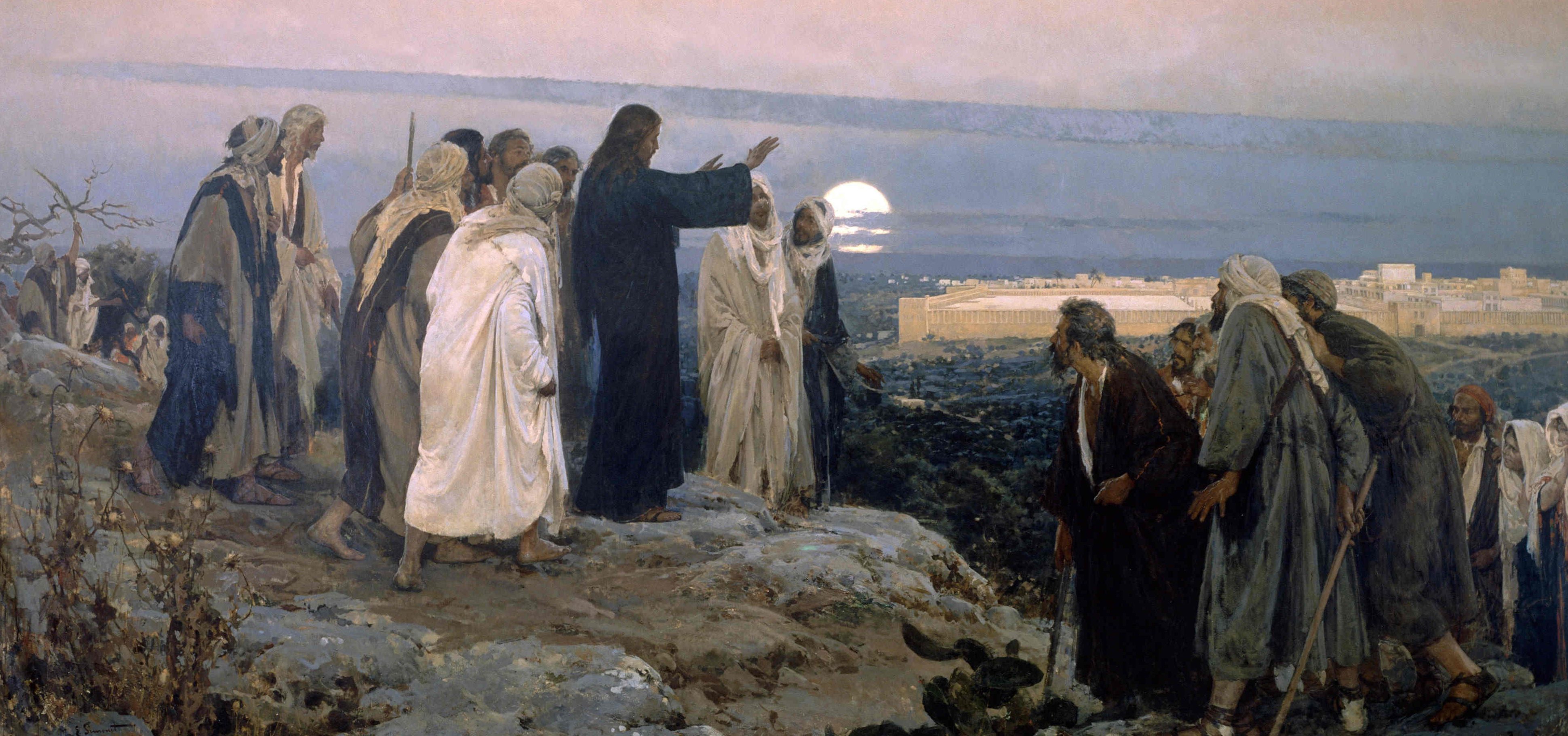
30 Nov Reflections on Misunderstanding
The Gospels sometimes tells stories of misunderstanding. The horizon of misunderstanding in St. Luke’s Gospel is Christ’s journey to Jerusalem – the journey into suffering, abandonment and death.
St Luke tells us that Christ set His face towards this horizon – meaning that He would not be diverted from it, but single-heartedly exposed Himself to it. At the same time those who surround Him – His disciples, as well as those who draw near with half-formed ideas of following Him – misunderstand what He is about, failing to grasp the horizon that draws Him.
Those who tentatively approach Him try to contain what being with Him might mean. One says I will follow you wherever you go. He assumes there is somewhere, some recognizable and reassuring place, towards which all this is unfolding. Another wants to remain rooted in family pieties, a third to detain himself in the circle of friendship. All three try to bring discipleship into subjection to familiar ways of understanding, as if it were a matter of adjusting or supplementing ordinary ways of living, instead of letting go, allowing oneself to be unforeseeably transformed in a way that changes everything.
The disciples themselves, by contrast, who at one level already belong to Him, understand that there is something utterly distinctive taking place. But at a deeper level they make the same mistake as those who are merely on the edge of things. For the disciples assume that the transformation that lies ahead will show itself as an exercise of power, a triumphal blaze of vindication and sovereignty. Lord do you want us to bid fire come down from Heaven and consume them? This too misunderstands the horizon. The disciples are more radical than the uncommitted, but nonetheless they are not radical enough. A transformation obtained through suffering, abandonment and death is unimaginable to them. In the end, the exercise of power they foresee as consummating the Master’s journey remains a worldly phenomenon, an intensification of something familiar rather than an unforeseeable passage to a new creation.
We ourselves can misunderstand Christ’s horizon of transformation, however, if we assume that He knew precisely what it would involve and thereby interpret Him heroically, as a kind of superman, in control of the future and thereby utterly self-assured in moving towards it.
It is true, as we have said, that He sets His face towards Jerusalem. But He does this in obedience, responding to the will of the Father and in accordance with the promptings of the Holy Spirit. What this will mean for Him is not necessarily clear to Him, nor is it necessarily clear to Him in advance that He will be able to endure it. For He does not carry His strength within Himself, as something He always already possesses, but rather He receives it, moment by moment, as He moves forward. He knows enough to realize that the consummation of His mission will make unprecedented demands upon Him, transcending all familiarity and security; He knows enough to be able to repudiate the very human misunderstandings of it that crowd upon Him, even from those most intimate with Him. But this clarity of vision is entirely compatible with a certain obscurity, an un-knowing, which will demand of Him, as His only support, an ever-intensifying self-abandonment into the hands of the Father.
Setting His face towards Jerusalem, in other words, has to be interpreted in the light of Gethsemane and all that flows from it, where the flood of anguish and fear, of uncertainty and powerlessness, first threatens to overwhelm Him. In this extremity, from which every other kind of security is being almost surgically removed, the only recourse is to be found in obedience and blind trust. Not my will but Thine be done. The path to Jerusalem – which in truth is no path, no way that can be seen, but a radical being-led – this path to Jerusalem reaches its greatest intensity on the Cross, in the apparent disappearance of the Father, by Whom alone He can be sustained. Such oblivion Christ may have in some sense foreseen, but in another way it was unforeseeable, indeed unthinkable, showing itself as an horizon to be grasped only in being undergone – and then, in being undergone, showing itself beyond all grasping.
In this light, Christ’s replies to those who approach Him take on a deeper significance.
Firstly: No one who puts his hand to the plow and looks back is fit for the Kingdom of God. He Himself is irreversibly committed to the will of the Father. He means to find no consolation that would deflect Him from it: what the Father asks of Him, and everything that He asks, constitutes alone the journey He must take. And it is this purity of heart to which He also calls, and will embolden, those who would follow Him. Indeed, their following Him will be, for each one, his or her own unique way of participating in the radical obedience and abandonment embraced by the Son of Man.
And then secondly: Foxes have holes and the birds of the air have nests. But the Son of Man has nowhere to lay his head. In obedience and abandonment He sets His face towards Jerusalem, but this means, paradoxically, that there is nowhere, no place, to which He is heading, nowhere in the world which in the end will offer Him shelter or security. For He is moving, or is being taken, towards the very limits of the world, and then beyond them. He is heading towards death and to dwelling among the dead. And this too is an essential dimension of following Him. Every disciple will, in some unique manner, participate in this death. This is so because at last, of course, he or she must depart from the world by dying. But even before that, the disciple of Christ dies, in Christ, to all that would compromise or distract him from trusting in God.
So the only path the disciple can follow, the only place in which he can ever find himself, must be centred upon this stance of radical dependence before and towards the Father. This stance is the stance of Christ Himself. It is also what He offers to us as redemptive.
Two of Christ’s replies remain, however, that we have not yet considered. The first is barely a reply at all. It is a turning and a rebuke, which we can easily imagine was wordless – at least, if Christ spoke, what He said is not recorded for us. The disciples, James and John in this case, incur this repudiation because of their desire to deploy power and manifest sovereignty: they would like to bring down vengeance from heaven upon the Samaritans who refuse to receive their Master. What Christ shows them is that whatever is unfolding here, it is not concerned with power and sovereignty and retribution. Such fantasies entirely misunderstand what He has come to reveal and accomplish. There is no question of exposing or punishing: the Son of Man desires only to accompany and thereby to redeem.
This is the deepest reason why it is so mistaken to see His journey through the horizon of the Cross as heroic, even as in some way superhuman. It is the humanity of His anguish, His very vulnerability and helplessness, that marks His solidarity with us, in which He accompanies us to the very limits of our own frailty. And it is only by fully and unreservedly inhabiting those limits that He can redeem us. For He has to show us another way to be. But what He shows us is another way to be ourselves – not a way of becoming superhumanly strong, but a way of being humanly weak before God. So He comes to us even in weakness, in fact above all there, when we find ourselves at the furthest distance from the power and sovereignty we all crave, when suffering and alienation threaten to overwhelm us entirely. It is there that we find Him – or, rather, it is there that He finds us. And we receive from Him, there, the grace to endure, the grace which He Himself received from the Father. This grace found Him, remember, even when the Father had apparently abandoned Him, and no clear sense of God was able to sustain Him. He accompanies us there, even there, so that we need never find ourselves without Him.
In craving fire from heaven, the disciples seek power, not redemptively, to suffer, but righteously, to punish. What Christ opens up to them instead is the way of Love.
And so He can also say: Leave the dead to bury their own dead; but as for you, go and proclaim the Kingdom of God. The way of Love is the way of Life. Besides this, every other way is a way of death – the loveless death from which He came to save us. But here the paradox of the Gospel reaches a new level of intensity. For the way of Love, the way beyond death, must at the same time travel through death. It must do so, not because the extremity of death, or indeed any other kind of intense anguish, has the slightest value in itself, for in themselves suffering and death are entirely negative. But the way of Love cannot evade the ultimate negativity. Beyond all evasion it must endure it, so that the power of Love – a power which is exposed only in powerlessness – can be clarified and communicated. A Love that stopped short, that contented itself in playing only this side of the horizon of dying, would be no Love at all. It would be a mere imitation, incapable of speaking definitively to the human condition.
So the way of Love tolerates no sentimental, or even tragic, deflection – not even the piety of burying the dead. For aside from the Love revealed on the Cross, the living are themselves dead, confined in an unredeemed, but also undisclosed, solidarity with mortality. Aside from the redemptive solidarity of the way of Love, each of us exists in a solidarity with the dead which is profoundly sinister, a kind of inversion of solidarity in Christ. This dark solidarity first hides itself beneath the communal diversions of loveless living, only at the last to unveil itself as dividing and consuming us.
And yet neither life nor death need be like this – and the urgency of Divine Love among us demands that they not be.
By Fr Philip Cleevely, Cong. Orat.

